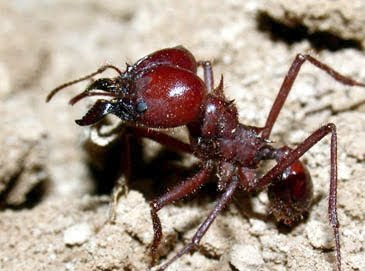Philosophy


Termites are a serious problem for property owners but in nature, they do have a proper place.
Forget about the big guys — elephants, zebra, buffalo. On the African savanna in central Kenya, it's really the termites that are running the show.
Four years of painstaking work by ecologists counting bugs, spiders and geckos have shown that a fungus-cultivating termite that goes by the name Odontotermes montanus creates oases of biodiversity in a dry landscape.
The termites do this by bringing sand and aeration to the area's typically compacted clay soils, allowing for greater moisture penetration. They also enrich the dirt with nitrogen and phosphorus as a byproduct of their labors, making it more fertile.
The underground termite nests, which can be centuries old, are grass-covered, treeless rings between 30 and 100 feet across, with a circle of comparatively lush acacia trees surrounding them. They attract high levels of insects, which in turn attract spiders and Kenya dwarf geckos, making for a much richer ecosystem than the surrounding plain.
In addition, the nutrient-rich soil and the plants that grow in it are "like these little supermarkets of the savanna, where there are delicious and abundant foodstuffs, so everyone comes," says Todd Palmer, a biologist at the University of Florida-Gainesville and one of the authors of a new paper on the subject. The larger animals in turn deposit waste there, making the soil even richer.
Theorists have talked for years about whether these processes result in greater biodiversity, but the researchers, whose paper is published in this week's issue of the journal PloS Biology, prove it.
"What's so great about the study is it represents some very intrepid and detailed field work," says Oswald Schmitz, a professor of environmental studies at Yale University who wrote a commentary on the paper in the same journal. "This was the first time that investigators have come together to really look at the many and complex dimensions of the story."
The scientists also studied how the nests the termites build create a gridlike array, defined by the limits of the area one nest can defend.
The research is also useful for local farmers. The termites eat only dead plant material, so it's possible to grow crops on top of them. Farmers sometimes dig up the mounds to mix the sandier, more porous soil around, but in doing so, they're actually destroying an engine of biodiversity.
"Productivity is maximized if you leave the gridlike pattern in place," Palmer says.
- Why Are Termites So Rich In Protein?
If you are familiar with body-builders or just meat-heads in general, then you know that they are obsessed with protein (and probably human growth hormone and anabolic steroids and a bunch of other supplements). But if these folks are really serious about...
- Mankind And Wildlife
International Year Of Biodiversity Maybe there is a relationship. "Wildlife: Protecting Biodiversity Might Just Protect Us From Disease" by Bryan Walsh December 1st, 2010 Time Biodiversity—what's it good for? Of course anyone lucky enough to...
- Biodiversity...not A Rosey Picture
International Year of Biodiversity "Despite Global Action, Biodiversity Is Declining" by Bryan Walsh April 29th, 2010 Time In 2002, environment ministers from around the world gathered in The Hague for a major summit on the Convention on Biological...
- Human Health And Biodiversity
International Year of Biodiversity I never thought this would be a problem but it is worth consideration. "Biodiversity now a public health issue" by Kate Melville December 4th, 2009 Science a GoGo The decline of species and their habitats may not...
- International Year Of Biodiversity 2010
Objective: Raise awareness of the importance of conserving biodiversity for human well-being and promote understanding of the economic value of biodiversity. The UN declared 2010 the International Year of Biodiversity (IYB). Throughout the year countless...
Philosophy
Termites...important feature of biodoversity
Internation Year of Biodiversity


Termites are a serious problem for property owners but in nature, they do have a proper place.
"Termites create pockets of biodiversity in African savanna"
by
Elizabeth Weise
May 25th, 2010
USA TODAY
by
Elizabeth Weise
May 25th, 2010
USA TODAY
Forget about the big guys — elephants, zebra, buffalo. On the African savanna in central Kenya, it's really the termites that are running the show.
Four years of painstaking work by ecologists counting bugs, spiders and geckos have shown that a fungus-cultivating termite that goes by the name Odontotermes montanus creates oases of biodiversity in a dry landscape.
The termites do this by bringing sand and aeration to the area's typically compacted clay soils, allowing for greater moisture penetration. They also enrich the dirt with nitrogen and phosphorus as a byproduct of their labors, making it more fertile.
The underground termite nests, which can be centuries old, are grass-covered, treeless rings between 30 and 100 feet across, with a circle of comparatively lush acacia trees surrounding them. They attract high levels of insects, which in turn attract spiders and Kenya dwarf geckos, making for a much richer ecosystem than the surrounding plain.
In addition, the nutrient-rich soil and the plants that grow in it are "like these little supermarkets of the savanna, where there are delicious and abundant foodstuffs, so everyone comes," says Todd Palmer, a biologist at the University of Florida-Gainesville and one of the authors of a new paper on the subject. The larger animals in turn deposit waste there, making the soil even richer.
Theorists have talked for years about whether these processes result in greater biodiversity, but the researchers, whose paper is published in this week's issue of the journal PloS Biology, prove it.
"What's so great about the study is it represents some very intrepid and detailed field work," says Oswald Schmitz, a professor of environmental studies at Yale University who wrote a commentary on the paper in the same journal. "This was the first time that investigators have come together to really look at the many and complex dimensions of the story."
The scientists also studied how the nests the termites build create a gridlike array, defined by the limits of the area one nest can defend.
The research is also useful for local farmers. The termites eat only dead plant material, so it's possible to grow crops on top of them. Farmers sometimes dig up the mounds to mix the sandier, more porous soil around, but in doing so, they're actually destroying an engine of biodiversity.
"Productivity is maximized if you leave the gridlike pattern in place," Palmer says.
- Why Are Termites So Rich In Protein?
If you are familiar with body-builders or just meat-heads in general, then you know that they are obsessed with protein (and probably human growth hormone and anabolic steroids and a bunch of other supplements). But if these folks are really serious about...
- Mankind And Wildlife
International Year Of Biodiversity Maybe there is a relationship. "Wildlife: Protecting Biodiversity Might Just Protect Us From Disease" by Bryan Walsh December 1st, 2010 Time Biodiversity—what's it good for? Of course anyone lucky enough to...
- Biodiversity...not A Rosey Picture
International Year of Biodiversity "Despite Global Action, Biodiversity Is Declining" by Bryan Walsh April 29th, 2010 Time In 2002, environment ministers from around the world gathered in The Hague for a major summit on the Convention on Biological...
- Human Health And Biodiversity
International Year of Biodiversity I never thought this would be a problem but it is worth consideration. "Biodiversity now a public health issue" by Kate Melville December 4th, 2009 Science a GoGo The decline of species and their habitats may not...
- International Year Of Biodiversity 2010
Objective: Raise awareness of the importance of conserving biodiversity for human well-being and promote understanding of the economic value of biodiversity. The UN declared 2010 the International Year of Biodiversity (IYB). Throughout the year countless...
